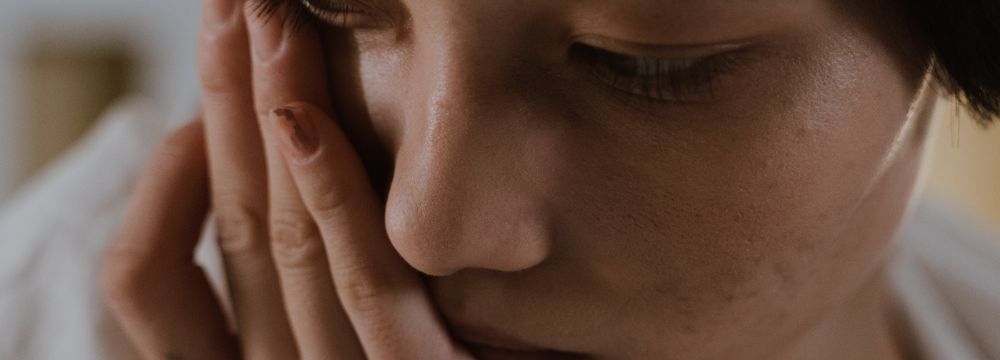What Is an Anxiety or Panic Attack? Current Tips & Treatments

Almost everyone can relate to feeling anxious from time to time. That unease before your big test or butterflies in your stomach during a speech is common. But what happens when anxiety overwhelms and results in a cascade of unpredictable physical symptoms such as lightheadedness, racing heart, impending doom, breathlessness, sweating, and dizziness?
This manifestation of anxiety is known as an anxiety attack, or in its most severe form, panic attack. Panic disorders are quite common, with an NIMH-estimated 4.7% of U.S. adults experiencing panic disorder at some point. Panic attacks are even portrayed routinely in movies and TV shows – think Ted Lasso.
This condition can make patients feel helpless and at the mercy of their unpredictable attacks. It can become a vicious cycle. The good news is that combining lifestyle changes such as mind-body techniques and therapeutic and medical interventions can manage panic attacks. The first step in taking control of this condition is recognizing the signs and symptoms of a panic attack and learning ways to diffuse them effectively.
This article will explore what an anxiety or panic attack is and how lifestyle changes can manage it. We will also discuss when it might be time to seek medical and clinical assistance to get better control over your symptoms.
What Is An Anxiety Attack?
The terms anxiety or panic attack are often used interchangeably to describe an abrupt surge of intense fear or discomfort. They typically occur without much warning, reach their peak within 10 minutes, and rarely last longer than 30 minutes. Panic attacks are also accompanied by four or more specific physical symptoms, which can include:
- Palpitations, pounding heart, or accelerated heart rate
- Sweating, trembling, or shaking
- Sensations of shortness of breath or smothering
- A feeling of choking, chest pain, or discomfort
- Nausea or abdominal discomfort
- Feeling dizzy, unsteady, light-headed, or faint
- Chills or heat sensations
- Numbness or tingling in the extremities
Although panic attacks have a relatively short duration, the intense feelings of terror can cause people to feel like they are going to lose control, are detached from themselves, are not in reality, or are going to die. Additionally, the physical symptoms can be so intense that a person may think they are having a heart attack. The intensity of the symptoms makes panic attacks a leading cause of emergency room visits for suspected chest pain known as angina.
After an anxiety attack passes, the fear of the possibility of having another one, especially in a public space, can become consuming. This fear can cause people with panic disorders to avoid public places or destinations where they feel they can’t access help.
At-Home Treatments for Panic Attacks
Although these attacks can be terrifying, they do not cause any actual threat to a person’s health or safety. By becoming aware of the symptoms of a panic attack and learning how to manage them, a person can regain control of their life.
If you are experiencing symptoms of a panic attack, you can try these simple techniques that use the mind and the body to help calm your system and support other therapies.
Awareness
One of the first steps to getting control over panic attacks is understanding that these attacks will not cause you any physical harm. Although they might be scary, bringing awareness that these attacks are not dangerous and always end can give a person back their freedom.
Awareness statements can help calm the mind and body during an attack. Repeating these statements to yourself, either aloud or in your mind, can assist in bringing you into the present moment until the uncomfortable sensations pass.
Awareness statements to try can include:
- “I am safe, and this will pass.”
- “I have been through this before and can get through this again.”
- “This feeling is uncomfortable but not dangerous.”
- “I am here now.”
These statements can help you cultivate a sense of control and safety in a panic attack.
Guided Imagery
Guided imagery is a relaxation technique that harnesses the power of the imagination to form a pleasant mental picture of an object, place, event, or situation that can replace the negative or stressful feelings a person is experiencing. This technique can be self-directed or recorded by a therapist.
Numerous studies have shown that guided imagery can effectively reduce anxiety symptoms in people seeking general stress and anxiety relief with various medical conditions, such as patients undergoing hemodialysis, patients with irritable bowel syndrome, patients with preoperative anxiety, and patients with acrophobia or fear of heights.
During a panic attack, utilizing guided imagery may look like actively taking yourself out of the present situation and into the mind. Whether you are visualizing a warm sunny beach or a cozy Sunday morning on the couch, seeing a place where you feel calm, peaceful, and serene can take the mind out of the uncomfortable moment and ease your symptoms.
Measured Breathing
An elevated breathing rate is a common physical symptom of a panic attack. Intentionally slowing the breath sends messages to the mind that the body is calm, which often leads to bringing down the mind.
Research has shown that paced breathing, or slowed breathing techniques, can activate the parasympathetic portion of the autonomic nervous system, responsible for our rest and relaxation response. Using breathing techniques to activate this system can help ease the symptoms of a panic attack.
Try these breathing techniques the next time you feel a panic attack begin:
- Prolonged exhalation: Take a deep breath in through the nose for a count of 4 and exhale through the mouth for 6 or more
- Box breathing: Breath in through the nose for 4, hold the breath for 4, and exhale for 4
- Belly breathing: Breath in deep through your nose, bringing the air into the belly, and exhale with a sigh through the mouth
Grounding Through Sensation
During the intense feelings of a panic attack, grounding methods can help ease symptoms by using the five senses to help you come into the moment and step away from negative thoughts. Grounding using different senses can effectively calm a panic attack while it is occurring.
You can try a few techniques to see which works best for you and your symptoms.
- Cold exposure: This sensory technique uses temperature to break a negative thought pattern. Cold exposure can be achieved by dipping your face or hands in ice-cold water for 30 seconds.
- Touch: Using our sensation of touch can help ground the body. Try squeezing a stress ball, spinning a fidget, or petting a soft blanket or pillow.
- Smell: Sometimes, the sensation of scent can help someone come out of a state of anxiety and into the moment. Try smelling your favorite scented hand lotion, candle, or essential oil.
Laughter Therapy
Laughter therapy utilizes techniques of creating both natural and mimicking laughter and combines yoga movements and breathing styles to calm the mind and body. During laughter therapy, you are encouraged to focus on the experience of laughter and the associated positive bodily sensations, grounding you into the present moment. Although laughter therapy is a relatively new field of research, it has been shown to improve anxiety symptoms in some patients.
This therapy can be used during an attack to break up feelings of fear and stress and can also be used afterward to elevate the mood and signal to the body that you are safe and calm. Implementing laughter therapy regularly may help to ease anxiety symptoms and result in reduced occurrence of panic attacks.
When to Speak to a Professional
If you are experiencing recurrent panic attacks, speaking to a licensed mental health professional about your condition is the best next course of action. Panic disorder is diagnosed when a person has recurrent unexpected panic attacks followed by at least one month of persistent concern about having additional attacks, worry about the attack’s implications or consequences, and a significant change in behavior related to the panic attacks. This condition is treated with talk therapy, medication, or a combination of both.
Talk Therapy Techniques
One of the most common treatments for panic disorders includes undergoing talk therapy with a licensed mental health professional. This may include working with a psychologist, psychiatrist, social worker, or mental health therapist.
One of the most effective treatments for panic disorder includes cognitive-behavioral therapy (CBT). CBT teaches people how to reframe inaccurate or negative thinking so they can view situations in a different light and respond to them more effectively. This helps people with panic attacks reframe negative thoughts surrounding their attacks, fear of another attack, and the consequences of these feelings more constructively.
Medication Therapy
Panic disorder can be treated with certain medications, often taken daily, under the care of a physician. A class of medications known as selective serotonin reuptake inhibitors (SSRIs) are considered the first-line pharmacological treatment. Another type of medication known as tricyclic antidepressants (TCAs) may also be prescribed. These medications can help reduce symptoms and the occurrence of panic attacks.
Panic attacks can be a frightening and overwhelming experience. They are categorized by intense fear or discomfort and by uncomfortable physical sensations that may make a person believe they are in serious impending danger. Thankfully through mind-body techniques, psychological therapy, and medication management, panic attacks can be appropriately managed. If you are suffering from panic attacks but are not currently under the care of a medical professional, it is best to seek help to get a knowledgeable treatment team to help you reclaim your life and mental health. We encourage you to speak to the Sylvia Brafman Mental Health Center admissions team to learn more about our outpatient and PHP treatment programs that can be very effective in helping you manage these sorts of attacks now and in the future.



